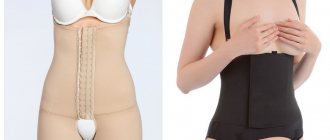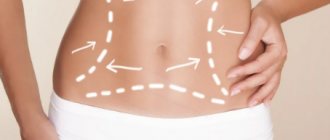Abdominoplasty results
- In 1-2 weeks, when the swelling goes away and the stitches are removed, you will be able to appreciate your new shape. Thin waist, flat stomach, no extra folds or fat deposits.
- It is recommended to wear compression garments for a month after surgery to speed up healing. After 6 weeks, you can return to your usual physical activity and sports.
- The results of a tummy tuck can be fully assessed after 6 months. The swelling of the tissues will completely subside, the scars will become lighter, and the previous sensitivity will return.
Rehabilitation after abdominoplasty
In recent years, abdominoplasty has confidently taken a leading position among other plastic surgeries. Patients who seek help from a plastic surgery center to change the relief, shape of their figure, or remove excess fat must understand exactly what problems they will face after plastic surgery. The plastic surgery clinic will provide excellent care throughout the rehabilitation process, which guarantees a quick recovery of the body without complications. Initial recovery after surgery will take a month. It will be possible to fully recover after plastic surgery in 6-8 months, subject to strict adherence to the regimen prescribed by the doctor who performed the plastic surgery.
The first stages of rehabilitation after abdominoplasty
The appearance of the patient after plastic surgery can be shocking if you do not prepare in advance for the upcoming changes. Swelling, bruising, scars in the area of the operation spoil the impression of the quality of the work done by the specialist.
- After anesthesia, a person experiences attacks of dizziness, nausea, and weakness. Depending on the individual's response to surgery, each patient responds differently to anesthesia. The situation will begin to stabilize on day 2-3 of hospital stay.
- Drainage tubes protruding from the abdomen drain excess fluid. This helps to quickly get rid of swelling and speed up the healing process of postoperative wounds. If there are no complications, the drainage is removed for 3-4 days.
- To relieve pain that appears after the anesthesia has stopped working, it is possible to take analgesics prescribed by your doctor. Tablets or injections will be needed during the first 2-7 days. Gradually the pain dulls. There remains slight discomfort due to the wound.
- After completing the tummy tuck, the patient is put on compression garments designed to minimize the load on the suture. It should not be removed even at night. A special belt or bodysuit must be worn for at least 1.5-2 months.
- The stitches are removed after two weeks. The scar is clearly visible above the underwear throughout the year. Gradually, the color and convexity of the scar become less noticeable, but they will never disappear without a trace.
Important!
Do not panic after the operation when you see scars, swelling, and bruises. The body will gradually restore its usual appearance, and modern cosmetic products will help get rid of scars.
Waking up from anesthesia
Abdominoplasty is a complex job that requires good professional training and extensive practical experience. The surgeon will have to remove a large flap of skin and fat in the front of the abdomen to move it down. The separated muscle tissues are sutured, the navel takes a new position, and liposuction is performed. All manipulations are performed under general anesthesia so that the patient does not feel pain. At all stages of the operation, the functioning of internal organs, pressure, and breathing is monitored. The body is under severe stress. After surgery, the patient is transported to a ward where he is monitored by medical staff until the anesthesia wears off. Each patient recovers from anesthesia differently. In any case, the first minutes will be unpleasant, for which you need to prepare in advance.
Rehabilitation after abdominoplasty by day
The companions that you will have to put up with during the first month are stiffness, a lot of swelling, and bruising. The pain will gradually disappear during the first week. Analgesics will help cope with unpleasant sensations.
Inpatient postoperative period
Having completed the work, the plastic surgeon puts a bandage and special compression stockings on the patient, then he is transported to the intensive care unit, where he waits until the anesthesia wears off. If there are no complications, the patient is moved to the ward. The first week after tummy tuck, the patient is observed by a doctor in the hospital. This reduces the risk of complications.
The first two days will be spent lying on your back with your legs slightly bent in order to relieve as much tension as possible from the stitches.
- After anesthesia, nausea, slight dizziness, and dry mouth appear.
- Attacks of pain in the surgical area will require the use of analgesics. Every movement will be painful. Coughing, sneezing, and touching the operated area are accompanied by pain.
- To quickly remove accumulated ichor, lymph, and blood, a drainage is inserted. Depending on how the wounds heal, the tubes will remain in the body from a day to five. Sometimes additional punctures are done to improve the condition.
- After surgery, patients cannot always go to the toilet normally, so they are given a catheter to drain urine.
- The first knocks are due to massive swelling, you can’t do without painkillers.
- A sharply decreased volume of the anterior abdominal wall and tight compression garments can create the illusion of a lack of air. The body needs time to get used to the new state.
- The appearance of the abdomen after surgery can cause serious psychological breakdowns, so it is best to look in advance at a photo of what a patient who has undergone abdominoplasty looks like.
The second day, if there are no complications, will be easier. You can sit up in bed with the help of relatives or staff.
To move around the room, you need to bend, relaxing the tension in the suture area as much as possible. You can start walking normally no earlier than in a month.
The third and fourth days already give an idea of how the figure has changed. During the normal course of rehabilitation, the drainage is removed. The wound will look scary, but it will be tolerable to perceive.
- To eliminate pain, you still need to regularly take painkillers, as well as other pills designed to speed up the healing process of wounds.
- The swelling begins to spread to areas of the body adjacent to the operated area, which is normal. However, if there is any reason for concern, be sure to tell your doctor.
- The period when any movement causes pain. You can only get up or lie down with the help of someone, so as not to strain your abdominal muscles.
You can leave the hospital if there are no side effects, if you feel good on the fourth day. The time of discharge is determined by the doctor, based on objective data about the patient’s condition.
On a note!
If you are planning to have a tummy tuck, take a vacation with the opportunity to extend it at your own expense. This is a complex operation that requires a long recovery period and support from relatives.
Outpatient postoperative period
Having arrived home, you will have to spend at least another week in bed, moving as little as possible. The stitches are removed approximately on the tenth day. After this, local agents are prescribed to stimulate wound healing. If tissue scarring is normal, the doctor will allow you to take a warm shower.
- It is better to walk in a semi-bent state, but you can already try to fully straighten up by doing special exercises, making sure that the skin tension is minimal. No sudden movements, heavy lifting or strong bending.
- After abdominoplasty, the sensitivity of the abdomen can change dramatically. Some patients do not feel their abdomen at all, while others, on the contrary, have inadequate reactions to heat or cold. The body returns to normal by the end of the second week, although it may take several months.
- Arriving home, you must strictly follow the diet prescribed by your doctor. Nothing spicy, sour, fatty, floury until tissue regeneration is complete. The diet will help you quickly get rid of swelling, bruises, and speed up the healing of sutures.
The first month after surgery should be limited to trips to the doctor. No household chores, cleaning, moving heavy objects, or exercising. If the work does not involve physical activity, you can come to the office after three weeks with increased activity. But it is better if you extend the recovery period for as long as possible.
Long-term operating period
- After a month of rehabilitation, the pain goes away completely. Unpleasant sensations remain with sudden movements or bending. Externally, the seam may become very red or increase in volume. This is a normal reaction of the body to the ongoing recovery processes after tummy tuck. The main thing is to monitor all changes so that if hypertrophy or keloid develops, you can immediately take the necessary measures.
- After a month and a half, you can attend physiotherapy procedures as prescribed by your doctor to speed up tissue regeneration and quickly get rid of swelling and bruises. Several exercises to increase blood flow and lymph movement will have a good effect on your general condition and will significantly speed up the healing process of wounds. Monitoring by your attending physician will help avoid complications. If you have any problems, immediately consult the surgeon who performed the plastic surgery.
- It takes several months for complete recovery. You can gradually increase the load, carefully observing how the body reacts so that the postoperative sutures do not come apart. The body gets used to the new state, any discomfort disappears. After six months, we can draw preliminary conclusions about how effective the plastic surgery was. Complete recovery takes a year or a year and a half.
Edema
The accumulation of fluid in tissues after surgery cannot be avoided. The body thus protects itself from large-scale damage caused by the surgeon to the body. During the first few days, swelling moves to nearby areas. The sides, groin, and chest begin to resemble swollen pillows. Gradually the situation returns to normal, and the tumors go away. The process requires control so that seroma does not develop or problems with the cardiovascular system arise. In addition, swelling may be the first sign of an internal infection. If your condition changes for the worse, consult your doctor immediately.
Compression bandage after abdominoplasty
Compression garments are placed on the patient immediately after the operation is completed, while the patient is still under anesthesia. The bandage is a wide belt without reinforcement ribs. After a couple of days, you can change it to special briefs, high-waisted shorts or a bodysuit. It’s not very comfortable to be in, but you can’t shoot during the first weeks or months for several reasons.
- Special underwear ensures an even distribution of loads on the back and abs, fixes the tissues in the desired position, and relieves pain.
- When moving, the fabric easily massages areas of the body, restoring normal blood supply, providing lymphatic drainage, and accelerating the process of swelling disappearance.
- Holds the sutures tightly, reducing the risk of divergence of the wound edges.
Important!
It is necessary to constantly wear compression garments for 1-2 months. At first, you can take it off only when taking a shower, then before going to bed. For up to six months, it must be worn during physical exercise to create the necessary compression.
What is possible and what is not possible after tummy tuck?
A patient planning to undergo abdominoplasty must clearly understand the complexity of the upcoming operation and understand that the period of complete recovery will take at least a year. By strictly following all the recommendations of the surgeon who performed the plastic surgery, you can significantly speed up the regeneration process.
- You will have to accept that during the first months you cannot do without compression garments.
- Any physical exercise in the first months is impossible, as it can lead to divergence of the edges of the wound and internal bleeding. Gradual loads taking into account tissue repair are useful under medical supervision.
- By walking from the first days, the patient stimulates blood and lymph circulation, which has a good effect on wound healing processes. You can walk actively without bending after 2-3 weeks.
- After two months, you can increase the load by doing light exercises, gradually loading the abdominal muscles. Jogging and going to the pool are possible if permitted by the attending physician after 2-3 months.
- After four months of recovery, you can gradually build up your muscles by lifting light weights.
- You can go to baths, saunas, solariums or visit the beach no earlier than in a couple of months. This increases the risk of infection getting into the suture and reduces the rate of tissue scarring.
- When visiting the beach, it is necessary to protect the seam from direct sunlight, since under their influence the scars darken, become rough, and increase in size.
- Intimate life will require a break for at least a couple of months. But even after this, you should refrain as much as possible from sudden movements and excessive stress on the area where the operation was performed.
- A strict diet is necessary for the first couple of months until the swelling goes away. Then you can move on to your usual diet, however, not forgetting that by abusing baked goods, sweets, and fast food, it is easy to gain excess weight, which completely neutralizes the surgeon’s efforts.
- Cosmetology surgeries, visits to tattoo parlors to completely hide the scar behind the design, perhaps in a year and a half.
According to statistics, the risk of complications after tummy tuck fluctuates around 5 percent. Surgeons know that most often problems are local and arise due to the individual characteristics of the body, which can be dealt with by adjusting the treatment. The main thing is that the patient immediately informs the attending physician about any difficulties during rehabilitation.
Is it possible to do liposuction after abdominoplasty?
Vacuum suction of fat deposits after tummy tuck is the least preferred method of figure correction. The subcutaneous fat layer will become thinner, which will worsen the aesthetic result of the surgical operation.
The exception is those cases when there is a significant difference in the thickness of the tissues above and below the scar line, or when “ears” form at the extreme points of the scar.
We recommend combining these two methods during one intervention. This is a safe and effective way to get rid of excess fat and overstretched skin. This is clearly demonstrated by photographs before and after abdominoplasty, as well as reviews from our patients.
Photo after abdominoplasty (tummy tuck)
Abdominoplasty is a surgical method of body contouring, which is carried out by reducing the fat “apron” and sagging skin, stretch marks and other cosmetic imperfections of the skin on the abdominal wall. This manipulation is a very complex surgical procedure that involves making three incisions in different parts of the abdomen. However, despite the traumatic nature of the procedure, the photo results after abdominoplasty amaze everyone without exception.
Maxim Osin, a competent specialist in the field of plastic surgery, at the first stage makes markings along which the incisions are subsequently made. Tissue dissection occurs around the navel, in the area where pubic hair grows, and, if indicated, a vertical incision is made in the direction leading from the pubis. Abdominoplasty - “before” and “after” photos allow you to evaluate the aesthetic effect of the operation: the waistline appears, the contours of the figure improve. Stretch marks on the skin are partially excised, which makes the skin on the body firm and elastic again. At the same time, postoperative scars are invisible to others. Abdominoplasty is a manipulation in the field of aesthetic surgery that returns women and men to their former appearance, fit and beauty.
If you want to make an appointment at the plastic surgery clinic with Dr. Osin, look at the materials on tummy tuck - abdominoplasty: photos before and after surgical correction will allow you to evaluate the surgeon’s qualifications and real results.
Our website contains photographs of patients who have undergone:
- Vertical abdominoplasty. This plastic surgery is indicated for patients who have excess fat on the sides and in the navel area. Thanks to the materials, you will be able to see the scar after abdominoplasty in the photos published on the website of the plastic surgery clinic.
- Lateral abdominoplasty. Tummy tuck (photos before and after surgery of real patients are also available on the website) allows you to emphasize your waist and make your figure ideal.
- Abdominoplasty with waist release. Plastic surgeon Osin performs this operation on patients who have severe bulging of the abdominal wall and a large amount of fat deposits on the abdomen.
- Endoscopic abdominoplasty. This method of abdominal correction is considered the least traumatic, since patients do not require large incisions on the abdomen. Photos will allow you to evaluate the results after plastic surgery, including the absence of large scars on the skin.
Abdominoplasty is often performed by women who are unhappy with their abdominal scar after surgical delivery. If you also need tummy tuck after cesarean section: photos of patients published on the site will help you make the final decision - agree to the operation or postpone it.
Evaluate real photos after abdominoplasty a year after plastic surgery - rest assured, you will be completely satisfied with the results.
Abdominoplasty
Abdominoplasty
A one-piece swimsuit, corset and shapewear help you hide your belly and create a beautiful figure, as if you had already had an abdominoplasty. But when you take off your shapewear, a discrepancy in the rectus abdominis muscles, a hernia, or excess fat and skin will immediately become noticeable. This is not only an aesthetic problem: a flabby, sagging belly can lead to intestinal prolapse, femoral hernias, and poor posture as a result of increased load on the spine in the lumbar-thoracic region. Such complications significantly reduce the quality of life and can even shorten its duration.
Are your sagging belly and stretch marks the result of laziness after childbirth?
Some women return to their previous shape after giving birth, and sometimes with the help of exercise and proper nutrition they can make their figure even better than before pregnancy. For others, the only way to look good is abdominoplasty. Hereditary factors will be important: connective tissue density, abdominal muscle strength, skin extensibility and collagen synthesis activity.
But it’s not only genetics that determines the condition of an adult woman’s abdomen. Also indicative:
● the age at which the woman experienced pregnancy and childbirth;
● number of births, fetal size, whether there was a multiple pregnancy;
● physical activity during pregnancy;
● the ability to wear a bandage during pregnancy and after childbirth;
● difficulty of childbirth;
● the opportunity to relax and take care of yourself after the birth of a child.
It is possible to remove stretch marks after childbirth with the help of medicinal creams and oils only if they were already barely noticeable, and treatment began from the day the scars appeared. Blue and red stretch marks on your stomach will remain in place, no matter what cosmetics you use. At best they will fade a little.
Tummy tuck after childbirth allows you to quickly bring your figure into ideal shape. Where training and conservative procedures cannot help, a plastic surgeon solves all problems with one abdominoplasty at a reasonable price. Today you can get rid of stretch marks and sagging skin, indestructible belly fat - and no longer spend money on shapewear, allow yourself to wear any open swimsuit.
Why doesn't my stomach go away after training and dieting?
Do you exercise regularly and watch your diet, but your stomach remains flabby and protrudes? This is one of the symptoms of rectus abdominis muscle separation. Most often it occurs in the supra-umbilical region and is combined with an expansion of the umbilical ring. Both of these conditions are the basis for the development of a hernia.
What you can notice on your own:
● The abdomen sags, and when the muscles tense in a lying position, it becomes a dome in the navel area or above.
● When you stand in front of a mirror in profile, you see a protruding and saggy belly in profile.
● You have an athletic build and no excess fat, but there is a noticeable depression in the midline of your abdomen, an expansion in the navel area.
What will abdominoplasty give you in our clinic?
You cannot control many natural processes, but with the help of modern plastic surgery you can remove their consequences.
Abdominoplasty in Kaliningrad is performed by our surgeons to the highest standards, taking into account your individual situation. The result of the operation will delight you for all the years to come.
We can help you in simple and complex cases:
● We sew together the rectus abdominis muscles, eliminating the hernia if necessary.
● We remove the skin apron and sagging flabby belly.
● We remove sagging skin with or without liposuction.
● Create a beautiful belly shape.
● We eliminate even severe stretch marks and scars.
● We form a beautiful navel area.
You do not need to delay surgery for several years if you are planning to have children in the future. After a tummy tuck, you can become pregnant and bear a child without any complications.
How to prepare for abdominoplasty
● If you smoke, the stitches will take longer to heal and may remain visible. We recommend giving up cigarettes at least two weeks before surgery, and not smoking for another month or two after.
● It is not recommended to consume alcohol and medications that contain acetylsalicylic acid less than 10-14 days before surgery.
● Immediately before the operation you should not eat or drink because it is performed under anesthesia.
How is a tummy tuck performed?
Before correcting the shape of the abdomen, the surgeon applies markings. These are the lines that the doctor will follow during the operation. They allow you to make precise cuts and correctly distribute the tension of the skin, muscles and aponeuroses.
The anesthesiologist will meet with you before the operation to calculate the required amount of anesthesia drugs and decide on their choice. If you are taking any medications, be sure to tell the anesthesiologist and your plastic surgeon in advance.
We determine the location and number of cuts individually, but all seams will ultimately be located where they are easiest to hide with linen. If it is necessary to make a vertical incision along the midline of the abdomen, it is stitched with a special cosmetic suture and once the scarring is complete it will not be noticeable.
The doctor stitches hernias and severe discrepancies of the rectus muscles first and strengthens them with surgical mesh. After this, he will remove excess fat under the skin, then trim the skin along the markings and apply cosmetic stitches.
If, when removing a skin apron or hernia, the navel is displaced, the surgeon will move it to the anatomically correct place and reshape it.
What happens after the operation
You will get a beautiful belly and a slim figure. You can wear open swimsuits, seductive lingerie, transparent tunics, and show off your neat tummy in crop tops. After abdominoplasty, creating relief on your stomach with the help of training will be much easier.
Recovery after surgery lasts up to one month. After 7-10 days, you can carry a child of 3-5 kg or exercise with this weight in the gym. After two weeks you will be able to lift up to 10 kg. All stitches will heal within a month after surgery and you will be able to wear open clothing. If you play sports, you can return to full training in two months.
The condition of the muscles, skin, and aponeurosis of the white line of the abdomen will recover faster and with better results if you complement your rehabilitation with procedures in our clinic. Hardware body techniques ICOONE Laser, VIP Line, and special care procedures are always available to our patients.
What is abdominoplasty
Abdominoplasty is surgical correction of the anterior abdominal wall. This means the removal of excess skin and fatty tissue (stretch marks, folds). It is considered a large, complex operation and requires general anesthesia. Although it is called plastic surgery, it is, first of all, a medical procedure.
Abdominoplasty allows you to close the stretched aponeurosis (diastasis) and remove the hernia. The result of this procedure is to give the anterior abdominal wall an aesthetic appearance. This means the absence of diastasis, a silhouette with a thin, formed narrow waist and the correct location of the navel.











